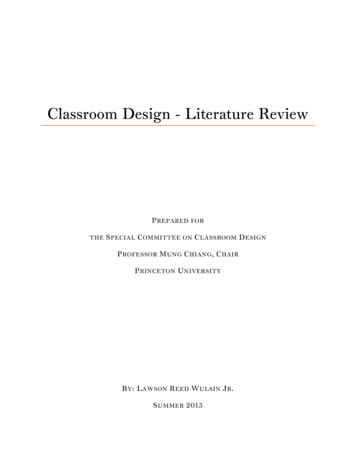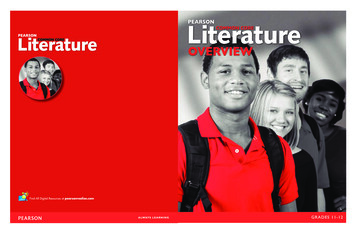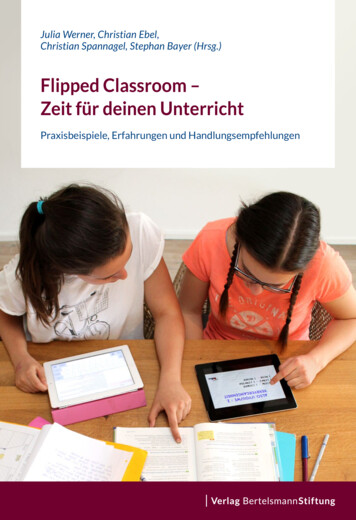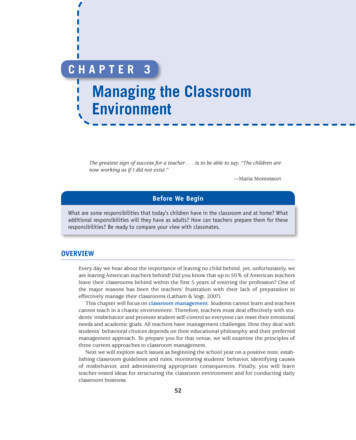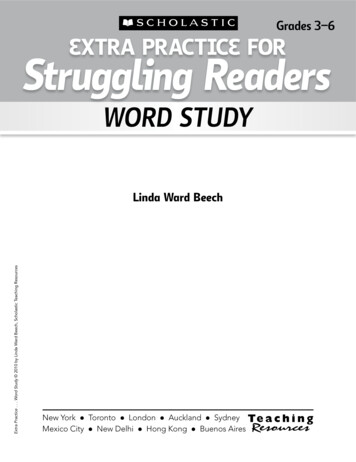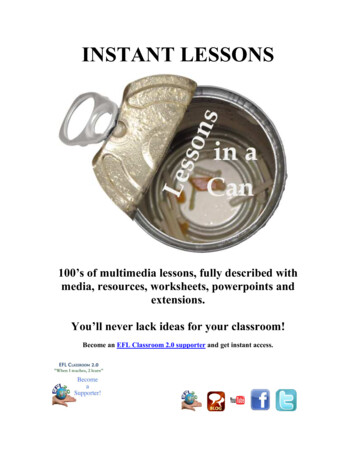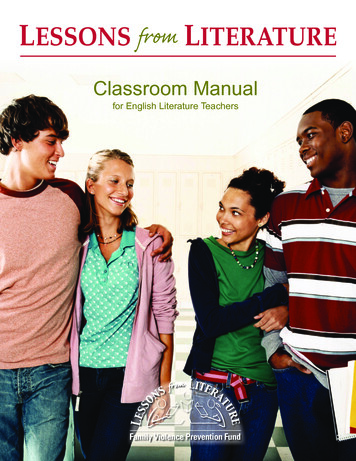
Transcription
LESSONS from LITERATUREClassroom Manualfor English Literature TeachersLESSONS from LITERATUREFamily Violence Prevention FundFamily Violence Prevention Fund1www.lessonsfromliterature.org
Dear Educator,As a teacher, you are a natural influencer, motivator and leader.Lessons from LiteratureSM is an innovative program that calls onEnglish teachers just like you – from all across the country –to bring violence awareness and prevention into your classroom.Every day millions of lives are devastated by violence within thehome and in the community. Teenagers, like adults, sometimesexperience violence and abuse in their young relationships as well.In fact, one in three teens reports knowing a friend or peer whohas been hit, punched, kicked, slapped or physically hurt bya partner.Lessons from Literature provides the framework for you to use thebooks and stories you’re already teaching to increase awarenessabout the damaging effects of physical, sexual and verbal abuse.Designed to integrate easily into your existing literature curriculum,the program empowers you with resources that help your studentsbuild key academic skills and meet national education standardswhile also learning to recognize abusive uses of power and controland alternatives to violence. Two in-depth lessons are included inthis manual to get you started, and we encourage you to createyour own lessons using the Lesson Template on page 26.Did You Know? 15.5 million U.S. children are living in homeswhere there is violence. Approximately one in three adolescent girls inthe U.S. is a victim of physical, emotional orverbal abuse from a dating partner. Nearly one in four women in the U.S. reportsexperiencing violence by a current or formerspouse or boyfriend at some point in her life.Sources and additional facts can be found atwww.lessonsfromliterature.org.The Family Violence Prevention Fund (FVPF) in partnershipwith the National Council of Teachers of English (NCTE),believes that if teachers can help shape the way young peoplethink and act now, relationship abuse and violence can beextinguished for the next generation. Ultimately, teachers whointegrate this program into their curriculum are helping adolescentsbuild healthy, nonviolent relationships today and tomorrow.We hope you’ll find our program valuable, and we wish you andyour students both academic and personal success.Respectfully,Esta Soler, PresidentLESSONS from LITERATUREFamilyViolence Prevention Fund 2009 Family Violence Prevention Fund. All rights reserved.Kent Williamson, Executive Director2www.lessonsfromliterature.orgLessons from LiteratureSM is a service mark of the Family Violence Prevention Fund.
Classroom Manual: Table of Contents4Supporting Student Achievement. Lessons from Literature helps students achieve successin school and in life by fostering the development of academic, social and 21st century skills.5Program Objectives. Lessons from Literature is designed to raise student awareness ofviolence and abuse in intimate and peer relationships, and equip students with tools andskills for choosing alternatives to violence.6Teaching Considerations. To help you prepare to integrate Lessons from Literature intoyour curriculum, please review the Teaching Considerations.7Strategies for Supporting Student Learning. Incorporate these reading and writingstrategies into the literature study to support student learning and comprehension.8Lesson: Their Eyes Were Watching God. Use this lesson to teach the program inyour classroom and/or as a model for creating your own lessons.Part I: Understanding Power and Control.11Part II: Deepening Our Understanding of Power and Control through Literature.12Part III: Assessment and Culminating Activities.13Discussions: Weaving Power and Control into the Central Literature Theme.149Lesson: Lord of the Flies. Use this lesson to kick off the program in your classroomand/or as a model for creating your own lessons.Part I: Understanding Power and Control and Their Impact.20Part II: Deepening Our Understanding of Power and Control through Literature.21Part III: Assessment and Culminating Activities.22Discussions: Weaving Power and Control into the Central Literature Theme.2318Lesson Template. The Template serves as a guide for modifying or creating your ownLessons from Literature lesson plans using other literature texts you are already teaching.27Lessons from Literature Handouts. The classroom handouts are designed to enhanceyour students’ learning experience in the Lessons from Literature program. The Powerand Control Wheel and Respect Wheel handouts provide a framework for exploring anddiscussing the themes of power and control, abuse and violence, and principles of respect.31Responding to Relationship Abuse. We have included a list of national organizations andteen helplines and recommend posting it in your classroom as a resource for students.39LESSONS from LITERATUREFamily Violence Prevention FundCreated in partnership with JMH Education, New York NYLessons from Literature Online. This section guides you through the Lessons fromLiterature website. The site is the central hub for the program; it’s where you can learn allabout the program, download the free materials and join our Teaching Community.www.jmheducation.comThe Lessons from Literature Classroom Manual contains the tools you need to help you integrate theprogram into your core literature curriculum.3www.lessonsfromliterature.org
Lessons from Literature Onlinewww.lessonsfromliterature.orgThe Lessons from Literature website is the central hub ofthe program. It provides easy access to all Lessons fromLiterature information and resources. All program materialsare FREE for teachers.Here’s what you’ll find at www.lessonsfromliterature.org: Downloadable Curriculum: This manual is your mainteaching tool. It contains the lessons, lesson templateand handouts to help you integrate the program into yourcore literature curriculum. About the Program: Learn about the program and readthe framework. Getting Ready to Teach: Review backgroundinformation and related terms about teaching the topicsof abuse and violence. Additional Resources: Download fact sheets on teendating abuse and other materials for teachers andstudents. Resource Library: Search the online compilation ofbooks, movies, poems and other resources to createyour own lesson plans or add a creative and meaningfulexercise to a pre-existing lesson. Teaching Community: Join your fellow teachers andshare lessons, resources, ideas and experiencesteaching the program. (See below.) Lessons from Literature Academy: A professionaldevelopment opportunity to learn and work with othereducators to prevent teen relationship abuse.Your Feedback Is Important To Us!Lessons from Literature was designed with the input of educators from all over the country to ensure the mostappropriate and relevant program for diverse students and settings. Please email us atlessonsfromliterature@endabuse.org to let us know how the program is working for you and your students.We’d like to hear what you like best and ways you’d like to see it improved. Your feedback will be carefullyconsidered as we continue to build additional elements for future years.Join Our Teaching CommunityYou’re invited to join the Lessons from Literature Teaching Community, an online community for teachers who arehelping their students build healthy relationships and inspiring them to create a conscious, responsible andrespectful 21st century. Submit your lesson plans, ideas and experiences in using the Lessons from Literatureprogram in your classroom. Go to www.lessonsfromliterature.org/community to join us today!LESSONS from LITERATUREFamily Violence Prevention Fund4www.lessonsfromliterature.org
Supporting Student AchievementLessons from Literature is designed to help students achieve success in school and in life by fostering the development ofacademic, social and 21st century skills. National Council of Teachers of English (NCTE): Lessons fromLiterature lessons are aligned with the English Language Standardsput forth by NCTE. The program is designed using pedagogicalprinciples that focus on developing advanced academic skills.Visit the Lessons from Literature website for a full list ofNCTE Education Standards met through the program, and alsocheck out www.ncte.org. American School Counselor Association (ASCA): Lessons fromLiterature helps students develop important academic andpersonal/social skills needed to achieve success in school and in life.For more information, visit www.schoolcounselor.org.Note: The ASCA National Standards for Students address theacademic, personal/social and career development of studentsso they not only achieve success in school but are prepared tolead fulfilling lives as responsible members of society. Partnership for 21st Century Skills: Lessons from Literature helpsteachers promote the development of 21st century skills by weavingthemes of global awareness and civic literacy into the study ofliterature. To learn more about the Partnership for 21st CenturySkills, visit www.21stcenturyskills.org.Note: The Partnership for 21st Century Skills believes schoolsmust move beyond a focus on basic competency in core subjectsto promoting understanding of academic content at much higherlevels by weaving 21st century interdisciplinary themes into coresubjects. These themes include: global awareness; financial,economic, business and entrepreneurial literacy; civic literacy;and health literacy.ASCALESSONS from LITERATUREFamily Violence Prevention Fund5www.lessonsfromliterature.org
Program ObjectivesLessons from Literature is designed to raise student awareness of violence and abuse in intimate and peer relationshipsand equip students with tools and skills for choosing alternatives to violence. The program helps students learn to:1. Describe the dynamics of abusive use of power andcontrol in relationships. Abusive uses of power and control in a relationship canlead to physical and sexual violence. Often, such violent behavior and choices are precededby other damaging, more emotionally-based abusesuch as coercion, threats, or hurtful language. Refer to the Power and Control Wheel on page 32 as avisual aid and for more examples.2. Explain the consequences of physical, verbal andsexual abuse and the impact of such abuse onindividuals and society.4. Create and communicate personal boundaries. Personal boundaries help define interactions thatare consensual, comfortable, nonthreatening andrespectful. Everyone has the right to communicate how they wantto be treated by others.5. Apply principles of respectful behavior towardothers in daily life. Refer to the Respect Wheel on page 33 as a visualaid; also use it as a starting point to create classroomand personal principles of respect. Abuse not only affects the victim and the abuser, butcan also affect their friends, family, and community. Consequences of abuse can be temporary orpermanent; they can be physical, emotional, healthrelated, economic, social and/or sexual. Some forms of relationship abuse – specifically, physicaland sexual assault – are illegal, and consequences caninclude suspension, expulsion or even incarceration ofthe abuser. Encourage your students to identify and explain theseconsequences when analyzing the literature.3. Identify and propose alternatives to using violence. Alternatives to violence are those behaviors and actionsthat do not cause or have the intent to cause harm. When considering alternatives to violence or analyzingthe choices made by characters in literature, it’simportant to understand that each situation is uniqueand that ways of responding safely and nonviolentlywill vary.LESSONS from LITERATUREFamily Violence Prevention Fund6www.lessonsfromliterature.org
Teaching ConsiderationsUsing the themes of power, control, abuse and respect exemplified in literature to facilitate classroom discussion andreflection about healthy, non-violent relationships may not be a familiar instructional approach. Below are considerationsfor integrating the Lessons from Literature program into your core literature curricculum.Grow Your AwarenessKnow Your Resources Be a model of respect and empathy.Get Help When NeededIn getting ready to teach Lessons from Literature, it’simportant to develop your own awareness of the dynamicsand impacts of physical, verbal and sexual abuse so thatyou are confident and prepared to address these issues inthe classroom. The Lessons from Literature website offers preparationmaterials and information to help get you started. Westrongly encourage you to review the online sectionsentitled Getting Ready to Teach and About the Program. Handle delicate situations carefully and withoutjudgment.Create a Safe and Respectful ClassroomBefore addressing the topics of abuse and violence, it’simportant to work toward creating a classroom environmentthat is conducive to open and respectful dialogue. Be sure to establish clear ground rules for studentinteractions. You may choose to have students sign apledge to demonstrate their commitment to these rules.There is no doubt that the sensitive topics of relationshipabuse and violence should be approached with care. Talkwith school administrators and counselors to learn aboutpolicies regarding harassment, abuse and physical andsexual violence. Be aware of the mandatory reportingrequirements that apply to you as a teacher. You maychoose to communicate these legal requirements to yourstudents.If you suspect a student is in an abusive or violent situation,be sure to take the proper steps to address the issue.Follow mandatory reporting requirements that apply to youas a teacher, and be prepared to refer a student to theschool counselor, a local resource, or emergency servicesif needed. Refer to Responding to Relationship Abuse onpage 39 for teen abuse services and domestic violenceagencies. Remember that you know your students best. Whenplanning class discussions and activities, consider theirmaturity level. Some topics may be better addressed ata later time.LESSONS from LITERATUREFamily Violence Prevention Fund7www.lessonsfromliterature.org
Strategies for Supporting Student LearningWe encourage you to incorporate some or all of the following reading andwriting strategies into the literature study to support student learning andcomprehension.In the sample lessons that begin on pages 9 and 18, we’ve referencedwhere they might be useful and relevant.StrategiesThink AloudsWhile reading, students in a small group share their thinking process in response to a text.They interrupt the reading of a text to intersperse mental pictures or questions, to puzzle overwords or meanings, to make connections from their own lives, to make predictions about thedirection the text will take, and to share their feelings about the text. Students can take turnsthinking aloud in this way with sections of text.Annotating Text/Talking to the TextReaders are invited to write their thoughts on the text as they read, raise questions, makeconnections and voice concerns. In pairs or small groups, they can share their differentmarkings, debrief the experience, and further discuss the text.Dual-entry JournalsAfter reading, the reader writes what he or she believes the text is saying, noting his/hercurrent understanding as a brief summary statement in one column, and in another, howhe/she has come to that interpretation. This could be seen as Evidence (I saw in the text) andInterpretation (I thought). After working individually on their evidence and interpretation charts,students can then share their sense-making in pairs or in small groups.Metacognitive LogsStudents can use logs to respond to essential questions or sentence stems as they read,such as, I was confused , I thought about , etc. as an ongoing routine.LESSONS from LITERATUREFamily Violence Prevention Fund8www.lessonsfromliterature.org
LessonTheir Eyes Were Watching GodA novel by Zora Neale HurstonLESSONSfromPreventionLITERATUREFamily ViolenceFundFamily Violence Prevention Fund9www.lessonsfromliterature.org
Lesson: Their Eyes Were Watching GodOverviewApproximate Time: 3 Weeks (daily 55-minute sessions)In the following unit, students will explore themes of power,control, abuse and respect in relationships and how theseimpact identity and self-growth of individuals and society in thebook Their Eyes Were Watching God. The terms ”power” and“control” refer to how power in an intimate or peer relationshipcan be used, either positively or negatively, to control orinfluence another person.This lesson incorporates media literacy to help studentsdiscover and analyze the impact various media have on ourvalues and thinking. It also incorporates observation researchto help students connect what they read in literature and absorbfrom media with their daily lives.MaterialsTheir Eyes Were Watching God –one copy of the novel per studentrecommendedTeacher PreparationPhotocopy Handouts (see page 31)– one per studentTheir Eyes WereWatching God 1937ISBN: 0-06-019949-0Learning Objectives Identify and describe power and control dynamics betweencharacters and relate these to Hurston’s use of imagery. Analyze the cyclical structure of Hurston’s plot and the novel’scharacter development to identify incidents of relationshipabuse in the literature. Explain the impact of abuse and violence on individuals andsociety. Identify personal boundaries for the novel’s protagonist andfor students’ own lives. Recognize the implications of media images and relate theseimplications to power, control and relationships. Create a media product or campaign to address the influenceof media on societal views of men and women.TermsPower, control, abuse, violence,consequences, principles ofrespectful behavior (See onlinesection Getting Ready to Teachfor term definitions.)English Language Standards Reading comprehension/Critical thinking/Analysis Writing expression Language/literary techniques, terms Research skills Cultural understanding Active (civic) participationPrint or download the full NCTE Education StandardsChart at www.lessonsfromliterature.org.Instructional SequenceOutlined below you’ll find the Lessons from Literature recommended instructional sequence for teaching Their Eyes WereWatching God. This lesson was designed to be taught as-is or integrated into your existing lesson plan for this book. Werecommend you tailor this sequence to your own teaching style and your students’ abilities and interests.Part I: This section kicks off the lesson with an activity tofamiliarize students with the themes of power, control, abuseand respect.Part II: This section deepens students’ understanding of power,control, abuse and respect after they’ve had the opportunity toexplore these themes in Part I.Part III: This section has culminating activities and assessmentopportunities that you can select from to complete this literatureunit. At this point in the lesson, it is assumed that students haveengaged in most or all of the Discussions, along with any otheractivities you’ve taught along the way.LESSONS from LITERATUREFamily Violence Prevention FundDiscussions: Designed to be integrated throughoutParts II and III of the lesson, this section offersdiscussion topics and activities that addressthemes of power, control, abuse and respect,as students make their way through the reading.These Discussions provide students with multipleopportunities to articulate their ideas, engage indialogue with their peers, and reflect on how theseideas relate to the text and the real world.10www.lessonsfromliterature.org
Lesson: Their Eyes Were Watching GodPart IPart IUnderstanding Power andControl and Their Impact1 Introduction: To activate students’ prior knowledge ofpower and control, have students come up with a listof people who they believe have power. Discuss waysthose people can use their power positively and/ornegatively. Then, ask students to make two lists: oneof people whom they think have used their power forgood, and one for those who have abused their power.Have students make brief notes describing theexamples of power. Explain that some people willappear in both categories because, while specificbehavior can be good or bad, people rarely fit intojust one category. Some examples of powerful figuresinclude: the school principal, the president, policeofficers, parents, teachers, and students. Discuss thetypes of power these people have and ways they canuse this power, both positively and negatively.2 Discuss: Introduce and distribute the Power andControl Wheel/PCW (see page 32) to students. Allowthem time to read and ask questions or comment. Askstudents to reassess their power and control lists fromStep 1. Does the PCW change any of their markings?Then discuss what students learned. What had theynot considered before about power and control?3 Homework: Have students collect imagery of males,females and relationships in society today (magazines,television commercials, television programs). You maychoose to have students do this from one or a numberof sources, which determines the time you will spendon this activity.TV commercials/program clips should be no longer thanthree minutes.4 In class: Introduce the short autobiographical piece,Girl, by Jamaica Kincaid. Have students annotatethe text as they read and listen. Then have studentsfree-write, considering the messages they havereceived during childhood about being a girl or a boy.You can find Jamaica Kincaid’s piece, Girl, online at:Bedford St. Martin’sVirtuaLit Interactive Fiction /fiction/)5 In groups: Introduce the concept of society’s influenceon shaping our beliefs through the use of media.Divide the class into groups and assign each groupone type of image or media. First, have students usethe think aloud strategy (see Strategies for SupportingStudent Learning on page 8) while examining theimage/media.6 Examine: Ask groups to use the two GuidingQuestions for Media Images handouts (see page 31)to carefully examine the messages regarding statusand behavior expected of respective genders. Havethem explore the implications that are communicatedvisually (photos) and verbally (TV/Internet). Theymay create dual-entry journals (see Strategies forSupporting Student Learning on page 8) for their work.7 Wrap-up: After students have finished, share theguiding discussion questions below. As students work,refer them to the PCW. Help students connect wherethe images might lead to issues of the misuse of powerand control and have them explain their reasons. How do these images and other advertisementssend simplified messages or stereotypes about theroles of men and women and how they shouldinteract? What are some of the consequences of thesemessages about relationships between people?Students may write a response to the images theyhave examined and what they have noticed/learned.LESSONS from LITERATUREFamily Violence Prevention Fund11www.lessonsfromliterature.org
Lesson: Their Eyes Were Watching GodPart IIPart IIDeepening Our Understanding ofPower and Control through Literature1 Examining the Cycle of Abuse: Have students dividethe book into four sections: Janie’s life with Nanny,with Logan, with Joe Starks, and with Tea Cake.Have students work in groups using the Plot Diagramhandout on page 38 to create a plot diagram for one ofthe four sections. Then, in a class discussion, havestudents share plot cycles and examine the abusecycles in the text. Introduce and distribute the RespectWheel/RW (see page 33). Help students makeconnections using the PCW and RW.2 Examining Relationships through Imagery: Like themedia, Hurston paints images throughout her novel.As a romantic writer, she uses a great deal of nature.Help students connect the nature imagery to the PCWand RW. How does Hurston use nature to reflect the state ofrelationships throughout the novel? Have studentschoose a section of the text and create a dual-entryjournal (see Strategies for Supporting StudentLearning on page 8) to examine the evidence (quoteand type of imagery: auditory, gustatory, olfactory,tactile, thermal, visual) and its effect (what it showsabout relationships).3 Wrap-up: Have students jigsaw what they havelearned in a class discussion and then create a Venndiagram (see example on page 26) to show where theysee overlaps in attitudes/behavior of characters. Theaspects can come from the PCW, RW, or the students.Expert Team 1InstructionalTeam 1Expert 1Expert 1Expert 1Expert 2Expert 5Expert 1Expert 1Expert 4Expert 1Expert 3Expert Team 5Expert Team 2InstructionalTeam 5InstructionalTeam 2Expert 5Expert 2Expert 1Expert 1Expert 5Expert 2Expert 2Expert 5Expert 5Expert 5Expert 2Expert 2Expert 4Expert 2Expert 5Expert 2Expert 5Expert 3Expert 4Expert Team 4Expert Team 3InstructionalTeam 4InstructionalTeam 3Expert 4Expert 3Expert 1Expert 1Expert 4Expert 4Expert 4Expert 4Expert 3Expert 3Expert 3Expert 3Expert 5Expert 4Expert 2Expert 3Expert 5Expert 4Expert 3Expert 2Expert 3Example Jigsaw Activity Set-upLESSONS from LITERATUREFamily Violence Prevention Fund12www.lessonsfromliterature.org
Lesson: Their Eyes Were Watching GodPart IIIPart IIIAssessment andCulminating ActivitiesAssessment Opportunities1 Learning to Make ChoicesAt the beginning of the novel, Nanny makes choicesfor Janie. Then, Janie begins to make choices forherself. Do her choices lead her to what she seeks?Write a persuasive letter. Use examples from the textand the PCW and RW to develop and support youranswer.2 Relationships and Social Norms: Then and NowEach of Janie’s relationships is complex, with bothpositive and negative aspects; she negotiates her waythrough each relationship, influenced by her familyhistory and the societal norms and expectations ofthe time. In a letter to Janie, discuss what her searchhas taught you about defining your own personalboundaries of what is acceptable or not in relationships.Considering societal and media influences onexpectations and roles of men and women, compareher struggles in defining personal boundaries andhealthy relationships in the early 20th century tocontemporary society. Use the PCW and RW, alongwith examples from the text and your own experience.3 Express YourselfWrite a letter to one of Janie’s husbands discussing hisbehavior toward Janie and the results of this behavior.Consider how the behavior affects the husband andJanie while referencing societal expectations and thehistorical context of the novel. Does their behavior helpeach of them achieve what they want for themselvesand their relationship? Use examples from the text andthe PCW and RW.Culminating Activities1 Observe and ReflectSpend one to three days conducting observationresearch: How do boys and girls interact? Considerany power and control dynamics at play, both positiveand negative. Then, analyze what you have learned ina written reflection, including evidence of behavior(s)observed, some thought on the motivations forthose behavior(s), and an explanation(s) of theconsequence(s) of those behavior(s). Conclude byconsidering the part each plays in using power andcontrol and ways boys and girls can avoid abuse bycreating personal boundaries and practicing theprinciples of respect.Observation research can be conducted in the schoolwhereby students analyze the behavior of their peers. As analternative, you can also choose to have students examinebehavior they witness on TV, in a movie, or in another formof media.2 Create an AdUsing the themes we’ve discussed throughout thisbook, including power, control, abuse and respect,create an ad that addresses relationships, friendshipsor other peer dynamics within our school. Your ad canbe a TV skit, radio script, billboard design or somethingsimilar. Use the media techniques explored in themedia images activity, the Guiding Questions forMedia Images 1 and 2 handouts (see pages 34–35),the PCW and the RW as references. You may choose to assign this as an individual project orhave students work in groups based on their interest in aparticular type of media. You may use the Media Literacy Rubrics (see pages36-37) or design a similar rubric.LESSONS from LITERATUREFamily Violence Prevention Fund13www.lessonsfromliterature.org
Lesson: Their Eyes Were Watching GodDiscussionsDiscussionsWeaving Power and Control intothe Central Literature ThemeTheir Eyes Were Watching God is a story of growing upand finding one’s identity. Janie, the protagonist, attemptsto find love, navigating through a series of relationshipsthat result in varying levels of freedom, alienation andabuse.Essential QuestionsThe following essential questions can help guide classdiscussion throughout the reading of the text: What is acceptable behavior in a healthy relationship? How do our families affect our behavior and ourrelationships? What does society expect of men and women in theirrelationships? How do these expectations impact society? How do the choices we make affect our lives and ourrelationships?Facilitating Safe and Respectful Class DiscussionYour students may not be familiar with discussing topics of relationship abuse and violence. If your students need a break from adifficult topic, you can reintroduce an essential question to guide the discussion toward more philosophical and general concepts. Youcan also assign dual-entry journals (see Strategies for Supporting Student Learning on page 8) or written reflections for studentsto explore their opinions and feelings beyond the discussion.Be aware of the mandatory reporting requirements that apply to you as a teacher, and be prepared to refer a student to the schoolcounselor, a
Lessons from Literature Online. This section guides you through the . Lessons from Literature. website. The site is the central hub for the program; it’s where you can learn all . Their Eyes Were Watching God. Use this lesson to teach the program in your classroom and/or as a model for c


